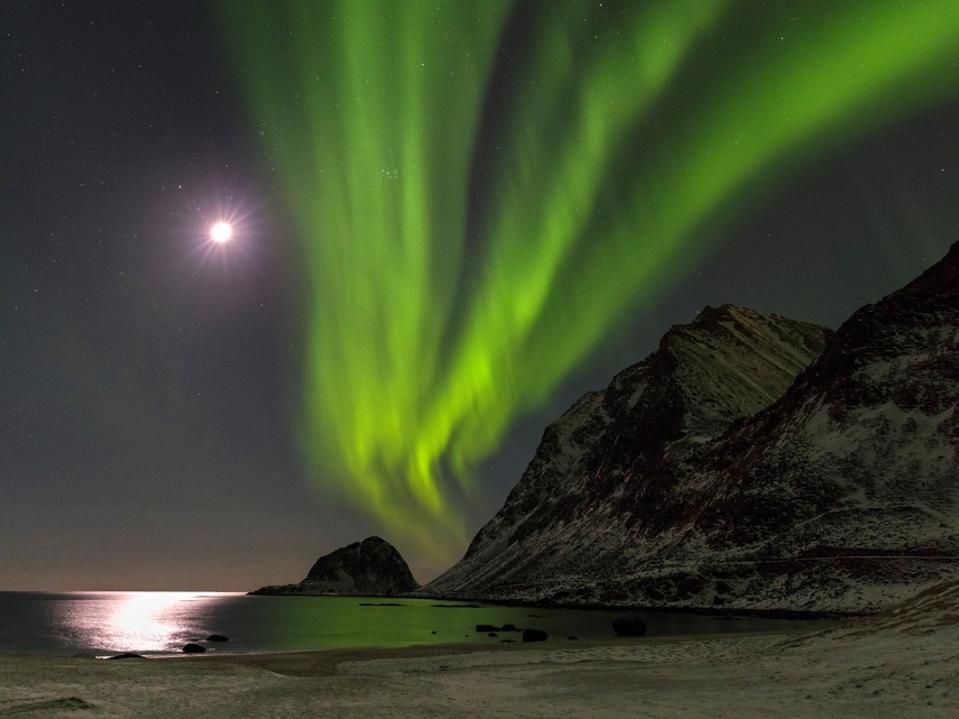Northern U.S. states could see the northern lights Thursday night, according to the National Oceanic and Atmospheric Administration.
The forecast from NOAA of a Kp index of four on a scale of nine for Thursday comes as a 97%-lit waxing gibbous moon shines brightly, bleaching the night sky and making faint phenomena — such as aurora — harder to see. It will rise during dusk on Friday as the full pink moon — here’s exactly when to see it from where you are.
Although the strong moonlight won’t help, from the Northern Hemisphere, the moon shines in the south, while the northern lights tend to be seen on the northern horizon.
According to NOAA, for a Kp in the range of 3 to 5, “if you are in the right place, these aurora can be quite pleasing to look at.”
Where To See The Northern Lights Tonight
Parts of U.S. states that could potentially see aurora, according to NOAA, include northern Washington, northern Idaho, Montana, North Dakota, South Dakota, Minnesota, Wisconsin, Michigan, Maine and along the U.S.-Canada border in Vermont and New Hampshire.
Alaska has a very high likelihood of seeing aurora, as does most of Canada save for southern New Brunswick and Nova Scotia.
Where And When To See Aurora
The aurora is usually seen from an auroral oval that hangs over polar regions at around latitudes of 70 degrees north and south at the Arctic and Antarctic Circles. However, that auroral oval can bulge, with displays seen as low as 25 degrees north and south of the equator.
The northern lights are most easily seen from September through March from across Alaska, northern Canada, northern Scandinavia and northern Russia, purely because there are more hours of darkness and darker nights.
However, when the auroral oval bulges during April and May it can extend into regions where there is still darkness — such as North America and Europe — as seen with the major display on May 10-11 last year.
The southern lights (aurora australis) can be glimpsed most easily between March and September in the south of New Zealand. The relative lack of landmass in the southerly regions of the Southern Hemisphere makes the aurora australis more difficult to see than its northern counterpart.
Are The Northern Lights Dangerous?
If either a solar flare (which travels at light speed) or a coronal mass ejection (which takes a few days to arrive at Earth) is strong enough, it can potentially devastate satellites, harm astronauts and damage electrical grids on the ground. Minor events regularly cause radio outages for mariners and short-wave radio users.
Major solar superstorms involving planet-wide aurora are rated as once-a-century events. The three we have records of occurred in quick succession — in 1859, 1872 and 1921 — over a century ago, so we’re probably due another one.
The most intense solar storm was the so-called “Carrington Event” of Sept. 2, 1859, when astronomer Richard C. Carrington observed a blast of white light from the sun for about five minutes. It was the biggest solar flare ever recorded, an X45, and produced planet-wide auroras. However, according to Live Science, it caused few issues to pre-industrial society besides electric shocks to telegraph operators.
A solar storm of similar intensity right now could have catastrophic effects; solar storms in Quebec, Canada, in 1989 and in Malmö, Sweden, in 2003 knocked out electricity grids. According to one study, it could cause over $41.5 billion of economic loss per day in the U.S., while another suggests that the internet could be at risk.
Wishing you clear skies and wide eyes.

